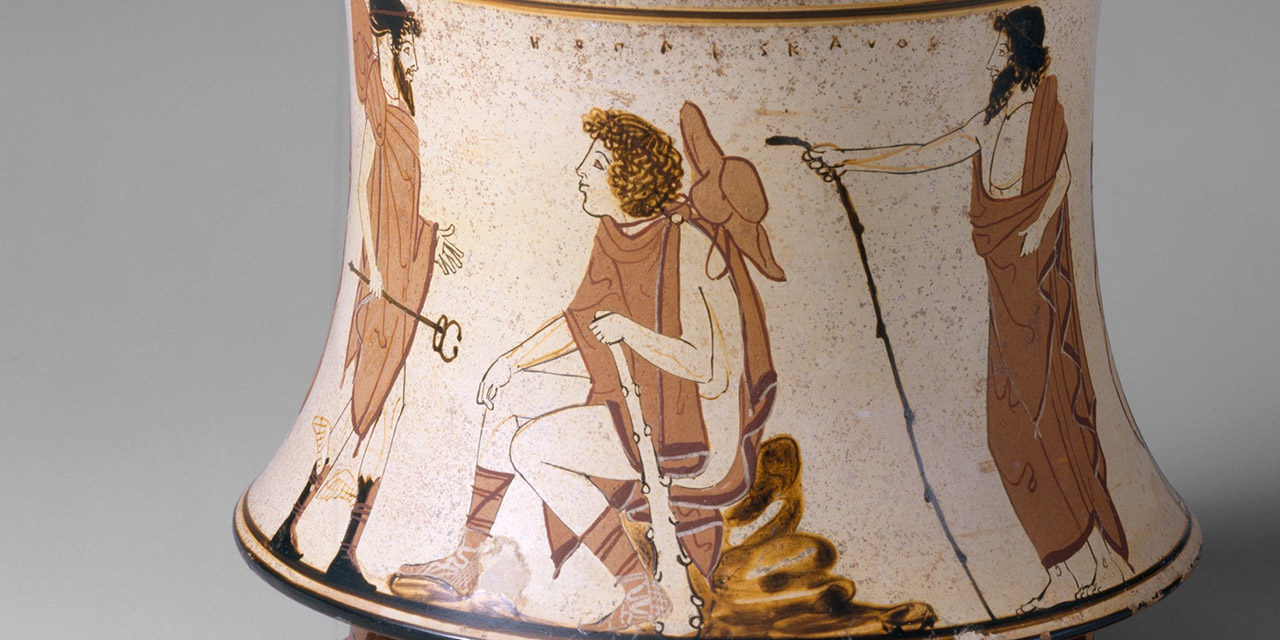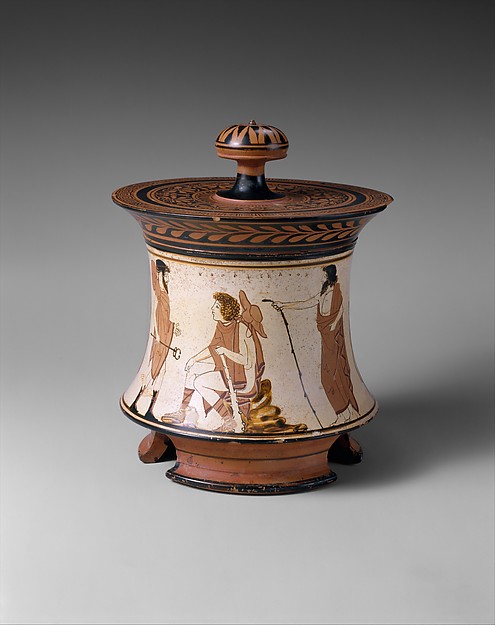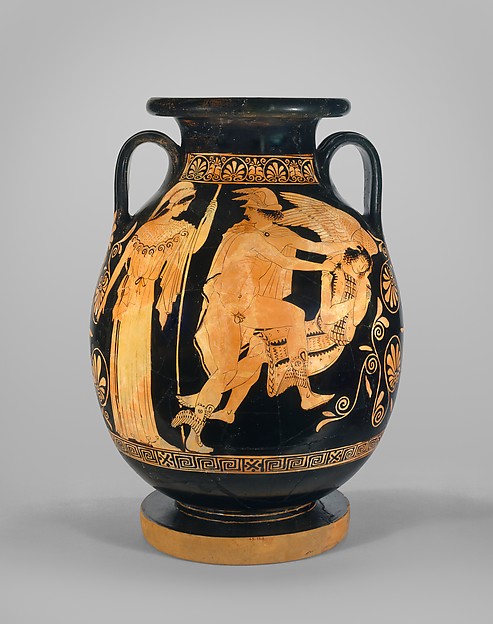A chlamys is a rectangular cloak fastened at the neck or shoulder that wraps around the body like a cape.
The Details
T
he Berg Dictionary of Fashion History defines a chlamys as:
“A rectangular cloak or mantle of wool cloth. Originally worn by soldiers, first as a loin cloth and then as an asymmetrical cloak, and then absorbed into general use and possibly worn over the chiton.”
According to Abrahams in Greek Dress, chlamys were worn over the short chiton by travelers and riders, hunters, horsemen, and was the characteristic dress of Ephebi. Like the himation, it consisted of a rectangular piece of material, but was a slightly different shape, being rather more oblong. In fact, when double it would form almost a perfect square (Abrahams 19).
Chlamys were mostly worn over the left shoulder and fastened at the right side of the body and much of the front uncovered (Brooke 28). Its normal dimensions would be about 6-7 feet long by 3 1/2 feet wide (Johnson 21).
Fig. 1 - Artist unknown (Greek). Oil flask (lekythos) with the hunter Kephalos and his dog, Early Classical Period about 470 B.C.. Ceramic, red figure; 39.2 cm (15 7/16 in). Boston: Museum of Fine Arts, 13.198. Francis Bartlett Donation of 1912. Source: MFA Boston
Fig. 2 - Artist unknown. Terracotta pyxis (box), ca. 465–460 B.C.. Terracotta; white-ground; h.12.1 cmwith cover 17.2 cm (h. 4 3/4 in with cover 6 3/4 in). New York: The Metropolitan Museum of Art, 07.286.36a, b. Rogers Fund, 1907. Source: The Met
Fig. 3 - Artist unknown (Greek). Terracotta pelike (jar), ca. 450–440 BC. Terracotta; red-figure; 47.8 x 34.3 cm (18 13/16 x 13 1/2 in). New York: The Met, 45.11.1. Rogers Fund, 1945. Source: The Met
Fig. 4 - Artist unknown (Greek). Terracotta lekythos (oil flask), ca. 480–470 BC. Terracotta; red-figure; 34 x 11.4 cm (13 3/8 x 4 1/2 in). New York: The Met, 25.78.2. Fletcher Fund, 1925. Source: The Met
Chlamys offered warmth and decoration and were often adorned with clavi, or purple stripes (Pendergast).
When war broke out, men, notably soldiers, had to change to the chlamys. The latter, ideal for riders, were sometimes ornamented and closed with a brooch on the right or left shoulder (Müller). The chlamys could be made from fine or richly decorated material (Müller).
In Fig. 1, Perseus is beheading the sleeping Medusa while wearing his chlamys like a cape. In Fig. 2, depicting the Judgement of Paris, the middle character is wearing a chlamys, with the characteristic side exposure. Fig. 3 shows the chlamys being worn as a cloak over another garment (likely an exomis).
References:
- Abrahams, Ethel Beatrice. Greek Dress: A Study of the Costumes Worn in Ancient Greece, from Pre-Hellenic Times to the Hellenistic Age. London: J. Murray, 1908. http://www.worldcat.org/oclc/922885017.
- Brooke, Iris. Costume in Greek Classic Drama. Westport, Conn: Greenwood Press, 1973. http://www.worldcat.org/oclc/868968649.
- “Chlamys.” The Berg Fashion Library. (n.d.). http://libproxy.fitsuny.edu:2105/view/bdfh/bdfh-div10975.xml (accessed 12 Feb. 2016).
- “Chlamys.” In Fashion, Costume, and Culture: Clothing, Headwear, Body Decorations, and Footwear through the Ages, edited by Sara Pendergast and Tom Pendergast, 123-124. Vol. 1, The Ancient World. Detroit: UXL, 2004. Gale Virtual Reference Library (accessed January 6, 2018). http://libproxy.fitsuny.edu:2540/apps/doc/CX3425500074/GVRL?u=fitsuny&sid=GVRL&xid=d71b032d.
- Johnson, Marie, Ethel Beatrice Abrahams, and Maria Millington Lathbury Evans. Ancient Greek Dress. 1st American ed. Argonaut Library of Antiquities. Chicago: Argonaut, 1964. http://www.worldcat.org/oclc/876463148.
- Müller, Mechthild. “Early History of Dress and Fashion in Continental West Europe.” The Berg Fashion Library. Sept. http://libproxy.fitsuny.edu:2105/view/bewdf/BEWDF-v8/EDch8010a.xml (accessed 19 Feb. 2016).
- Symons, David. Costume of Ancient Greece. London: Batsford, 1987. http://www.worldcat.org/oclc/833098278.














